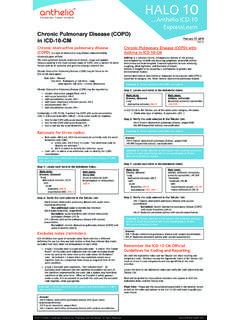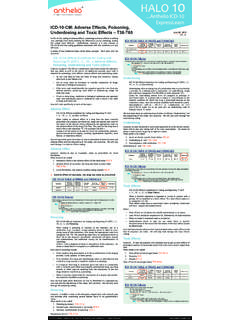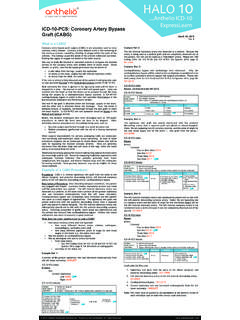Transcription of PICC Lines Arterial Lines 01 - Anthelio
1 ICD-10-PCS: Central Lines , PICC Lines & Arterial LinesCentral Lines In medicine, a central venous catheter ("central line ", "CVC", "central venous line " or "central venous access catheter") is a catheter placed into a large vein in the neck (internal jugular vein), chest (subclavian vein or axillary) or groin (femoral vein). It is used to administer medication or fluids, obtain blood tests (specifically the "central venous oxygen saturation"), and measure central venous Lines A peripherally inserted central catheter (PICC) is a form of intravenous access that can be used for a prolonged period of time ( for long chemotherapy regimens, extended antibiotic therapy, or total parenteral nutrition). A PICC is inserted in a peripheral vein in the arm (cephalic vein, basilic vein, or brachial vein), and then advanced proximally toward the heart through increasingly larger veins, until the tip rests in the distal superior vena cava or cavoatrial In ICD-9-CM Central Lines and PICC Lines (not totally implanted) all default to In ICD-10-PCS Central Lines and PICC Lines do not have a default code because of the specificity of the code set We need to train physicians to document in the operative report the anatomical site where the Central Lines and PICC Lines end and the planned use of the line Coding Clinic 3rd Q 14 p5-6 states, When the provider s documentation does not specify the end placement of the infusion device, the imaging report may be used to identify the body part.
2 This information is needed for accurate selection of the body part and device in the operative tablesICD-10-PCS Central line Example If a central venous catheter to be used for antibiotic therapy is placed percutaneously and ends in the superior vena cava, the ICD-10-PCS code assignment will be 02HV33Z ICD-10-PCS Index Insertion of a device in Vena Cava Superior 02HV ICD-10-PCS TabularNote: the code would change based on the final endpoint of the line placement and line proposed Lines Arterial line placement is a common procedure in various critical care settings. Intra- Arterial blood pressure (BP) measurement is more accurate than measurement of BP by noninvasive means, especially in the critically ill. Intra- Arterial BP management permits the rapid recognition of BP changes that is vital for patients on continuous infusions of vasoactive drugs.
3 Arterial cannulation also allows repeated Arterial blood gas samples to be drawn without injury to the patient. Arterial Lines can be placed in multiple arteries, including the radial, ulnar, brachial, axillary, posterior tibial, femoral, and dorsalis pedis In ICD-9-CM Arterial Lines all default to In ICD-10-PCS Arterial Lines do not have a default code because of the specificity of the code set We need to train physicians to document in the operative report the anatomical site where the Arterial line ends and the planned use of the line Coding Clinic 3rd Q 14 p5-6 states, When the provider s documentation does not specify the end placement of the infusion device, the imaging report may be used to identify the body part. This information is needed for accurate selection of the body part and device in the operative tablesICD-10-PCS Arterial line Example If an Arterial line was placed percutaneously into the left femoral artery for intra- Arterial blood gas draws the code would be 04HL3DZ ICD-10-PCS Index Insertion of a device in Artery Femoral Left 04HL Right 04HK ICD-10-PCS TabularNote: the code would change based on the final endpoint of the line placement and line proposed usage.
4 2014 Anthelio Healthcare Solutions Inc. Proprietary and confidential. All Rights SystemOperationMedial and SurgicalHeart and Great VesselsInsertion: Putting in a nonbiological appliance that monitors,assists, performs, or prevents a physiological function but does not physically take the place of a body part02HP Pulmonary TrunkQ Pulmonary Artery, RightR Pulmonary Artery, LeftS Pulmonary Vein, RightT Pulmonary Vein, LeftV Superior Vena CavaW Thoracic Arota0 Open3 Percutaneous4 Percutaneous EndoscopicZ No Qualifer0 Monitoring Device, Pressure Sensor2 Monitoring Device3 Infusion DeviceD Intraluminal DeviceBody PartApproachDeviceQualifierSectionBody SystemOperationMedial and SurgicalLower ArteriesInsertion: Putting in a nonbiological appliance that monitors,assists, performs, or prevents a physiological function but does not physically take the place of a body part04H0 Open3 Percutaneous4 Percutaneous EndoscopicZ No Qualifer3 Infusion DeviceD Intraluminal DeviceBody PartApproachDeviceQualifierB Inferior Mesenteric ArteryC Common lliac Artery, RightD Common lliac Artery, LeftE Internal lliac Artery, RightF Internal lliac Artery, LeftH External lliac Artery, RightJ External lliac Artery, LeftK Femoral Artery, RightL Femoral Artery, LeftM Popliteal Artery, RightN Popliteal Artery, LeftP Anterior Tibial Artery, RightHALO ICD-10 ExpressLearnDecember 3, the night before ICD-10, when all through the housenot a CDS was sleeping, their anxiety wouldn t douseThe code books were ready, studied with careIn hopes that the documentation would be thereThe coders were nestled.
5 All snug in their bedsWhile visions of procedure codes danced in their headsThe CFO was restless, the CEO tooTrying to trust the CDS knew just what to doThe next morning dawn came with a shatterThe CDS staff worked without much chatterCensus sheets printed off in a flashThey made assignments in a dashTo the floors they ran, with DRG books in towThe freshly waxed floors all a glowThe physicians all a rounding did appearWith their handy new CDI tip cards nearProgress notes were written, H&P s tooThe CDS s reviewed the charts, looking for a clueDiagnoses like asthma, a-fib and goutThe CDS staff was on the look outSpecificity was on their mindAcute or chronic their goal to findThen what to their wondering eyes did appear?The etiology and manifestations weren t quite clearA query must be done it was trueSo up to the physician the CDS flewThe physician agreed, and thanked the nurseHe appreciated her for being terseThe documentation was addedThe chart was completeThe CDS decided it was time to health records throughout the dayFeeling proud to be leading the wayYou see, ICD-10 it s not scaryOnce implemented we shall all be merryThe day is almost over relaxation in sightSo query now, query often, and to all a good night!
6 ~Shawn M. MacPhee, MSN, RN, CCDSC linical Documentation Improvement Educator, AnthelioShawn MacPhee's essay won Second Place in MACDIS (Michigan Association of Clinical Documentation Specialists) Essay Contest held in October 2014 2014 Anthelio Healthcare Solutions Inc. Proprietary and confidential. All Rights Reserved.









